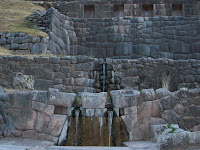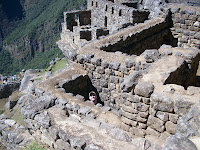Well, sadly, the extended vacation draws to a close, and along with it I suppose, this blog. I’ve had a lot of fun writing it. Oh, and I think I’ve fixed the posting feature now, so feel free to post some comments if you like….particularly if they are flattering in some way! Even though the vacation’s end draws nigh, we have still managed to do some pretty exciting things. I have some pictures posted here and on my Facebook page, but for more and better pics, you should really check out Mariel’s Facebook page.
This blog is late in coming, sorry Mom, but it includes two weeks instead of one. Sadly, after two successful months of eluding him, Moctezuma finally found me and exacted his revenge. I was being so careful...but it wasn’t so bad, no real loss except perhaps a kilo which I could easily afford, and a day in bed. Unfortunately, we did miss Alejandro’s birthday/karaoke party, which I really wanted to go to, a birthday, by the way, which he shares with the city of La Paz…so happy birthday to you both. La Paz is now 201. I’m not sure how old Alejandro is, but I’m awfully sorry to have missed what I am sure was a lot of fun.
As most of you probably know now, Mariel and I have decided to stay in La Paz for the next year. After some twist and turns throughout the labyrinths of government officials, rules, and regulations, of both countries, we determined the best course of events for us would be to stay here for year. That changes a lot of plans…the wedding scheduled for September in Virginia has changed to October in La Paz for one. We still plan a great ceremony back in Virginia when we return, so please keep us penciled in to your plans…just on the next calendar. I have found a job teaching English here in La Paz and will return to the US at the end of this month to settle some things. It is an actual job, not just juggling on Calle 25 for spare change, which was my first option. A big HUGE thank you to everyone on both sides of the family for all the help, both logistical and emotional, in regards to this change. We never saw this change of events coming, but it is exciting and we are looking forward to the next step. Ultimately, we’ll be back in the U.S., I don’t think I can stay away from 5 Guys Hamburgers for too long.
So, I may continue with the blogging, but just talking about work would probably get pretty boring after all the excitement of the last two months. We’ll see. But with that said…
On July 8th, Mariel and her mother took me to a very beautiful section of La Paz called Valle de las Ánimas, or the Valley of Souls. The geography was spectacular. We drove basically to the base of Mt. Illimani, and it’s immensity from this perspective was overwhelming to say the least.

Illimani
The snow caps made clouds appear just over its tallest peak and we got a view of Illimani’s sibling peak, Mururata. Well, peak is not really apt…it is a peak I suppose, but it is flat compared to Illimani. Legend tells us that at one time Mururata was the taller, sharper peak, but younger and jealous Illimani took a sling and with a massive boulder, decapitated his older, taller brother, leaving a smaller, more rounded Mururata. The geographic features of the Valle de las Ánimas are pretty incredible. It reminded me of the Roadrunner cartoons…some of the boulders on top of the sandy towers seemed to defy gravity in much the same way. We saw several black falcons swooping from their nests to check us out. I lost my sunglasses arm, and miraculously, Mariel found it for me…Over all, it was a pretty cool place. It had a rustic, country feeling and just minutes from the city.


The next big adventure was our visit to Lake Titicaca. Mariel, her mother and father, and I left the morning of the 13th for a beautiful drive to Copacabana, and yes the Barry Manilow song was running through my head…even thought that’s a different Copacabana of course. We drove up from Zona Sur, up and through El Alto and out into “the country,” country that is fast becoming engulfed by the rapidly expanding El Alto, but we passed several adobe huts and houses and numerous farms. We went up and over several mountains and after about an hour, Sr. Percy told me to look to my left, and peaking through a gap between two mountain tops I saw Lake Titicaca.

It was like a dark blue gem glistening between the yellow grassy mountains. It was utterly beautiful. As we drew closer, it seemed to expand and the horizon was lost; it was so large it looked like the ocean, but flat and tranquil. It glistened in the morning sunlight reflecting the sun, but seeming really to absorb the blue of the sky into its own dark, rich blue. Amazing.

Click on the pictures to make them larger.
Titicaca is one of the world’s highest lakes, and the largest lake in South America. The lake is both in Peru and Bolivia, according to Mariel it’s 51% Bolivian and 49% Peruvian. Also I have heard that Bolivia has the Titi ,and Preu has the Caca…but something tells me that joke is told differently in Peru.
When I tried to find out about the name I found that no one really knows the name’s orgin, but using the languages of Quechua and Aymara (the languages of the peoples from this area) it could mean “Crag of Lead” or “Rock Puma.” Some believe the Rock Puma name is most believable because from above the shape of the lake does somewhat resemble a puma hunting a rabbit. The lake also has several islands popular with visitors: Isle of the Sun (a sacred Inca island) and Isle of the Moon just to name two; there are about 40 others. Mariel and I plan to visit some of these soon. Interestingly enough it is also where the land-locked Bolivian Navy does its marine exercises.
In order to get to Copacabana we had to cross the lake on a Ferry, about a ten minute ride. We were able to get out of the car and take a few pictures.

View of Illimani and Murauata in the distance from the ferry

A very well-balanced dog on one of the ferries

Crossing on the Ferry
From this angle I was able to see the other side of Illimani. It’s beautiful from both sides. Then we drove up again and soon we descended toward the town of Copacabana; we could see it easily from the tall mountain pass nestled quietly on the shore of Titicaca.

Copacabana from the road; that's Al Calvario on the right.
Dominating the geography of the town is a giant hill now called El Calvario, or Calvary. The town itself contains the large, very beautiful, 16th century shrine Basilica of Our Lady of Copacabana, the patron saint of Copacabana. But it was a sacred place even before the Spanish, a distant outpost of the Inca it is believed to be a place where there lived a fertility god Kotakawana, the Aphrodite of Andean mythology. The Basilica is supposedly built upon an older temple dedicated to Kotakawana. If the usual modus operandi of the Spanish is true for Copacabana holds, this could be true. There is also the theory, if Wikipedia is to be believed, that the town’s names comes from the Aymara word Kota Kahuana, or view of the lake, but I haven’t verified this. Sounds plausible. Either way, it is a very beautiful place. Being there you can feel a deep spirituality.
Mariel and her mother and I climbed the tall hill/mountain called Calvary.

At the start
It is more of a spiritual walk that echoes the footsteps of Christ, with 14 stops and ending at the top with an amazing view of the town below and the surrounding lake.

About half-way
It wasn’t easy, but the view and feeling from the top made it worth the trouble. At the top, and on the way up, are several shrines and spiritual places. It is interesting to see the incorporation of traditional and Christian religions. We even passed one family and shaman performing some ritual; I was curious, but I didn’t want to be rude and stare. I have no idea what the ritual was for, but I did notice it included the use of firecrackers and lots of smoke.
Once we enjoyed the view and took some pictures it was time for the walk back down…equally difficult but a bit faster.

Pinching Mariel's car from about half-way up.
And when we got back to car it was definitely time for some lunch. We cruised around town for a bit taking in the views and vendors. There were lots of little stands with very interesting crafts, food, and gifts. We eventually found a restaurant where we enjoyed what I had been anticipating all day: Lake Titicaca Trucha. Fresh Trout!

OMG…I was not disappointed. Mariel and her family were right. The fish was outstanding. Then with our bellies full we walked a bit more and did a bit of shopping, then headed home, full, tired, and satisfied. We crossed on the ferry again and looking out I could see the Lake reflecting the sun in its deep, dark-blue depths. A truly, incredibly beautiful place.

Enjoying some Api...who knew you could make drinks from corn that aren't Alcoholic?!
After the fantastic visit to Copacabana, we rested a day or so and Mariel took me to central La Paz to see Plaza Marillo. Here is where you find the governmental center of Bolivia, and if you travel from here in any direction the Kilometers are measured starting from here. Here was where I finally got to see my first official “march” or protest. I’m not sure what they were protesting, but it was noisy and chaotic and pretty interesting to watch.

A protest march. I'm the tall one in the forground with the baseball cap:)
But more importantly, it’s here they have the “Witches’ Market.” Here you can buy most anything from Coca leaves to shrunken llama fetuses, good luck talismans and various herbs and potions for whatever ails you.

At the Witches' Market.
It was interesting to see, and smell, but very hard to describe. The roads are steep and cobblestone, the sidewalks are steep and narrow, so waking requires paying attention, yet at the same time, you want to look all around. So the tourists are easy to spot as they are the ones stumbling around looking in all different directions. I was one of them. But fortunately Mariel was there to help me along and do all the talking and negotiating…and she knew where she was going. That helps a lot! Poor Mariel has done a lot of translating and interpreting since I've been here. We've really kept her brain busy. And she has done it all without a minute of complaint. I don't know how she does it.
So, all in all, another very exciting couple of weeks. In another week, Mariel’s mother, Wecky, and I will travel back to Charlotte, and the vacation portion of this trip will sadly be over. But it certainly has been fun. Fun is such a small word to cover it…really, it has been the trip of a lifetime. One more food blog to go I think, and after that I’ll have to keep you posted. Check out our facebook pages for more pics if you are interested. Thanks for reading!

From the top of Calvary
Chau!













































